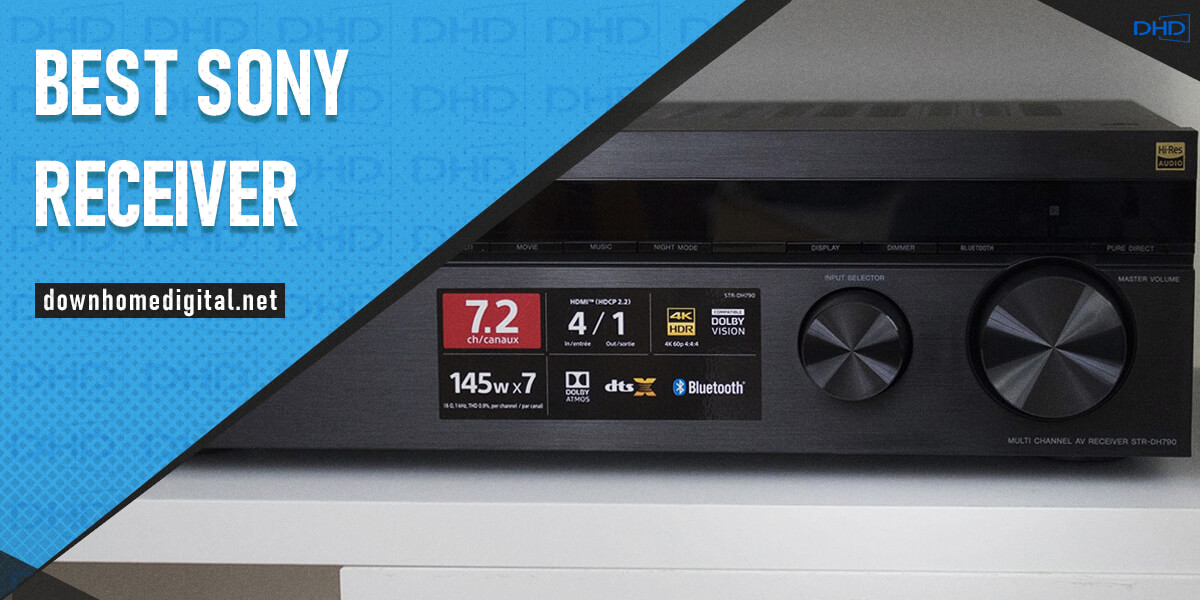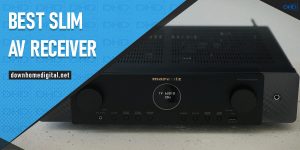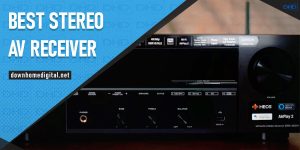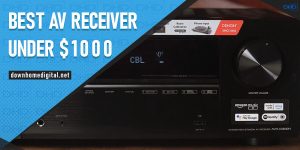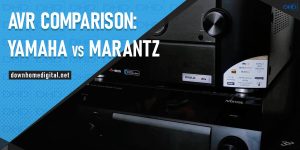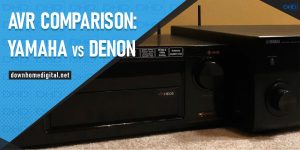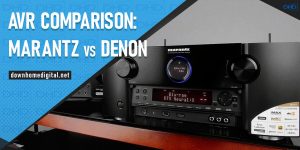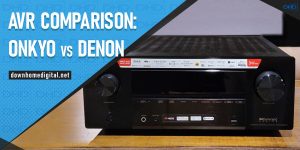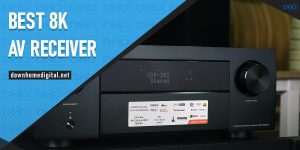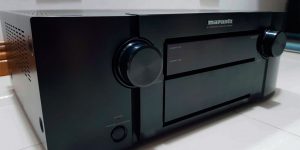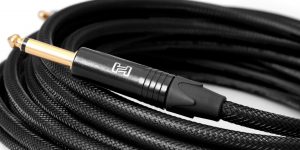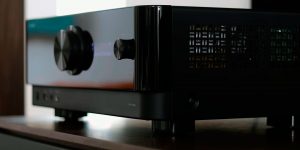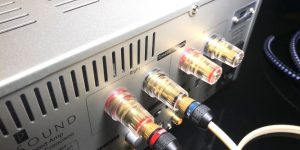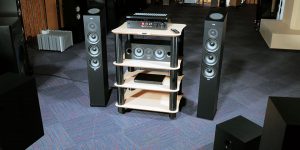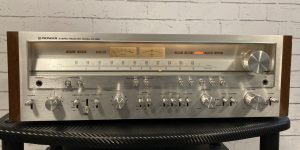AV receiver is a multi-channel device with digital audio stream decoders, tuner, and switcher for audio and video signals for use in home theater systems. These devices allow you to take sound to a whole new level and consequently get the most possible emotions from movies, music, or games. One of the old-timers and leaders in this market is Sony. Many people want to choose the best Sony receiver but get lost among the many series and models.
Today I have prepared the most unique and successful series of receivers from Sony. ES is Japan’s oldest hi-end series. It topped the company’s story with a more extraordinary aura than the competition because of the incredible quality that has earned her worldwide recognition. For over 40 years of its existence, ES has experienced everything: ups, downs, creating revolutionary things, registering many patents, and radically changing the market. I’m sure you are extremely intrigued. So let’s get to the fun part without delays!
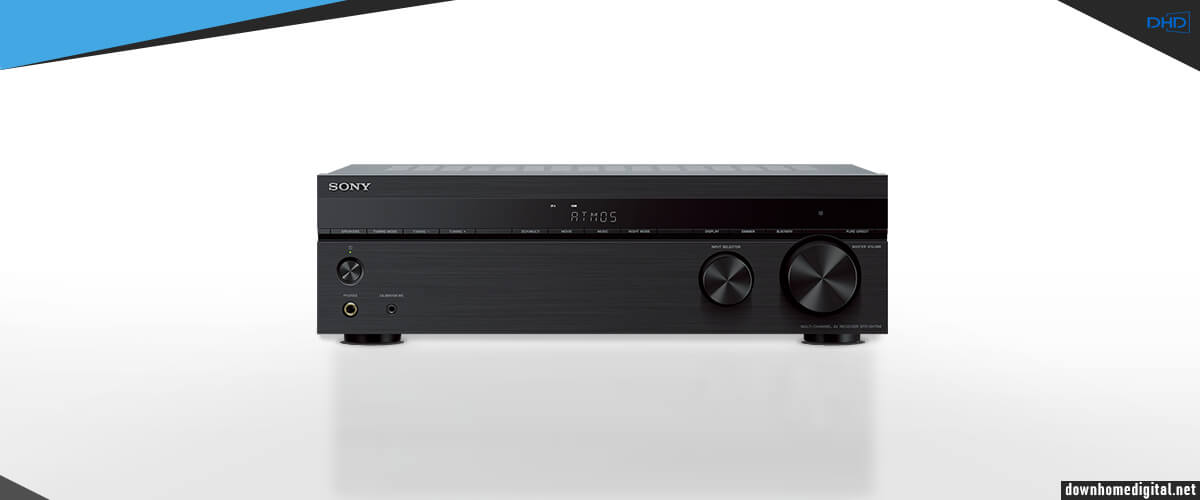
Sony receivers comparisson table
| Name | Channels | Power output | HDMI in/out | Bluetooth/Wi-Fi | Review |
|---|---|---|---|---|---|
| Sony STR-DH790 best overall | 7.2 | 145W/6 Ohm | 4/1 | yes/yes | Review |
| Sony STR-DH590 budget | 5.2 | 145W/6 Ohm | 4/1 | yes/no | Review |
| Sony STR-ZA3100ES under $2000 | 7.2 | 110W/8 Ohm | 6/2 | yes/yes | Review |
| Sony STR-ZA2100ES under $1500 | 7.2 | 105W/8 Ohm | 6/2 | yes/no | Review |
| Sony STR-ZA1100ES under $1000 | 7.2 | 100W/8 Ohm | 5/2 | yes/no | Review |
| Sony STR-DH190 stereo | 2.0 | 100W/8 Ohm | 0/0 | yes/no | Review |
Budget and expensive Sony receivers: what’s the difference?
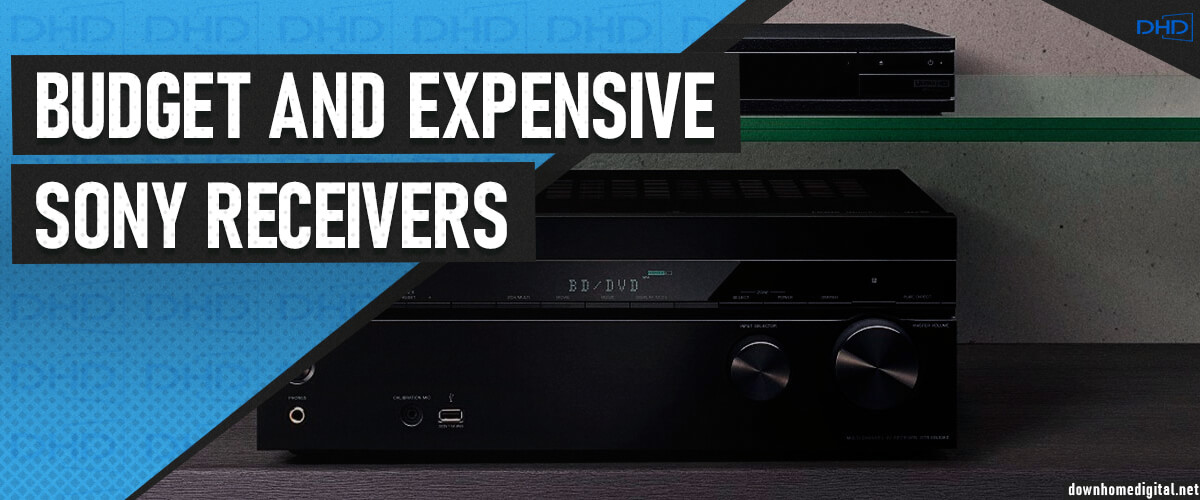
Choosing an AV receiver can be quite difficult for newcomers to the audio world due to the abundance of technical aspects. Therefore, to prevent you from buying an unnecessary or useless thing or spending too much money, I will help you to understand the main aspects.
First of all, you must answer the question – why are you building a multi-channel system? If this will be a basic home theater system, mainly focused on your TV’s networking and multimedia capabilities, then your choice will fall on the budget and mid-budget models. And if it is a full-featured home theater, which involves connecting any modern sources from a game console to a vinyl player, the choice is obvious – you need the model of the highest class.
With budget models, you will have a basic 5.1 system operating in Dolby Digital and DTS formats. Mid-range models and higher have a wide range of playable formats and can include such modern options as Dolby Atmos, DTS-X, Auro 3D, and the configuration expands to 11.2.
Do not forget that the capabilities of the video path also significantly affect the price. Many video outputs, components, HDMI pass-through, and more are found in top Sony receivers. But often, a wide range of users do not need this because the only thing they use is HDMI.
In addition, the Sony AVR becomes more expensive when, in addition to the video outputs, you have the option of up-scaling: the receiver scales the video input to 4K or even more. Moreover, 4K receivers come with a complete set of technologies without which the image will not be so good: HDR, Dolby Vision, HLG, and others.
As for other functions, the need for Wi-Fi, Bluetooth, DSD playback, AM/FM tuners, music streaming services with Hi-Res audio formats, and compatibility with multi-room technologies are present to some extent in most modern models. But the trend is the same – the more expensive the receiver is, the more extensive the set of wireless features you get. So in this regard, to choose the best Sony AV receiver, you should be guided solely by the tasks to solve.
How I picked and tested Sony receivers
I always approach the testing of models very carefully, especially when it comes to surround sound receivers. I test not only their features and functions but also surround sound and music capabilities. I chose Spider-Man: Homecoming, which I find perfect for the test.
And to assess the musical possibilities, I listened to the following tracks in different genres from different sources:
- The Weeknd – The Hills – Deezer
- Jacky Terrasson – Reach – Tidal
- Mahler – Symphony No.2 – Spotify
- Arctic Monkeys – Do I Wanna Know – (CD player)
- Led Zeppelin – Ramble On – (CD player)
- Bob Marley & The Wailers – Turn Your Lights Down Low – (CD player)
- Radiohead – The National Anthem – (CD player)
- Mark Nauseef – With Space in Mind – (CD player)
In my test, I used the following equipment to choose the best Sony receiver:
- CD player SACD 30n
- Blu-ray player Sony UBP-X700
- Speaker wire – AudioQuest Type-9
- Speakers for movie – Klipsch RP-8060FA
- Stereo speakers:
- Klipsch RP-8060FA
- KEF Q350
- DALI OBERON 5
Best Sony receiver reviews
Sony STR-DH790 – best overall

Many people often admire expensive models of the premium segment, but more affordable models, which optimally combine price and quality, deserve no less attention. Such a model is the Sony STR-DH790, which I put at the top of my list for a reason.
This model was released in 2018 and does not differ from its counterparts in other brands with modernity, with which its budgetary nature is associated. But a low price almost always means a compromise also in the design quality for inexpensive receivers. By design, at Sony, it is almost impossible to distinguish expensive models from cheap ones, but on the touch, it becomes clear. The weight of the STR-DH790 is only 16 lb. This suggests that the internal components are of low quality. But even the body is stuffed with plastic quite a lot. Buttons are flimsy and hardly get into the grooves, making clicks when pressed, but they don’t fall in. I turned the controls carefully and slowly as they wobbled and skipped the necessary values. Nevertheless, Sony’s appliances are somewhat nostalgic because they remind me of the 90s when the brand was extremely popular.
The first thing that catches your eye when looking at the box is the “145W x 7” label, which looks impressive. There are 7 channels in the model, and they are organized with enough flexibility to allow you to do two-way amplification of the front pair of stereo speakers or get surround sound from a pair of rear/upper speakers in Dolby Atmos and DTS:X format. I should note that future DH790 owners will have to make a few compromises. First, the receiver requires speakers with a minimum impedance rating of 6 ohms. Four-ohm speakers are not supported. Second, all channels, except for the front left and right, use spring terminals rather than screw terminals, which require cables up to 1.5 mm in diameter. In my opinion, such a solution was an unnecessary cost-saving measure.
The model has 4 HDMI inputs with the features associated with this standard. According to the list of specifications, they support signal quality up to 4K at up to 60Hz, HLG and Dolby Vision formats, 3D, Deep Color technology, BT.2020 color space, and HDCP 2.2 data protection protocol. There is only one HDMI output.
STR-DH790 has no analog video outputs, but there are four analog audio inputs, as well as coaxial and optical digital audio outputs. Of course, the selection is not the widest, but it’s enough for most small and medium-sized systems. There is also a 6.35 mm headphone output on the front panel’s left side.
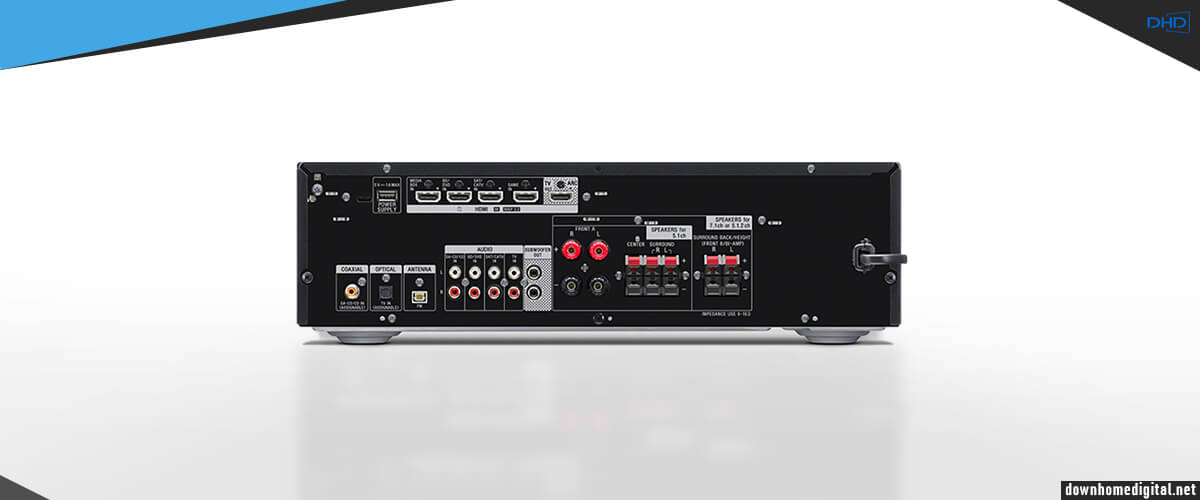
The model lacks some of the elements that users of expensive systems are accustomed to. For example, there is no second zone support, and media files are not readable through the USB port, which only serves as a power source for charging your smartphone or iPod. The lack of network connections such as Wi-Fi or Ethernet is also noticeable. However, Bluetooth is provided. Here, the receiver supports the AAC codec, allowing you to get sound from Apple devices in the finest possible quality for Bluetooth.
But is network constraint a serious factor in the purchase decision? In my opinion, it’s not. Most of the AV receiver’s networking tasks can be outsourced to much less expensive Blu-ray and Blu-ray UHD players. In addition, many networking tasks can be performed on modern TVs, including the same Sony Android models.
The receiver features auto-calibration, which detects the speakers’ size and distance from the listener’s position, sets their level, and adjusts the equalizer. The process is swift and simple, and you just need to place the supplied microphone in the right place and run it.
I would like to take a particular look at the Sound Effect option. It allows you to make important settings, namely to select the sound field, such as Dolby Surround, Neural-X, Front Surround, Stereo, etc. There is a description of each of these in the instruction manual. The wide range of sound settings with different effects makes it difficult to select them, so this feature, which offers ready-made audio modes, is convenient. The Sound Effect tab also has a night mode, EQ (low and high-frequency balance adjustment) for each pair of channels, and calibration type – Engineering, Front Ref, Full Flat, and Off. They define the pattern that the auto EQ curves should follow. Front Ref is designed for those who prefer to avoid powerful sound effects in the front speakers and prefer the other speakers to match them tonally. Engineering brings the sound up to Sony’s standard room frequency response. Full Flat equalizes the frequency response of all speakers, and Off disables EQ.
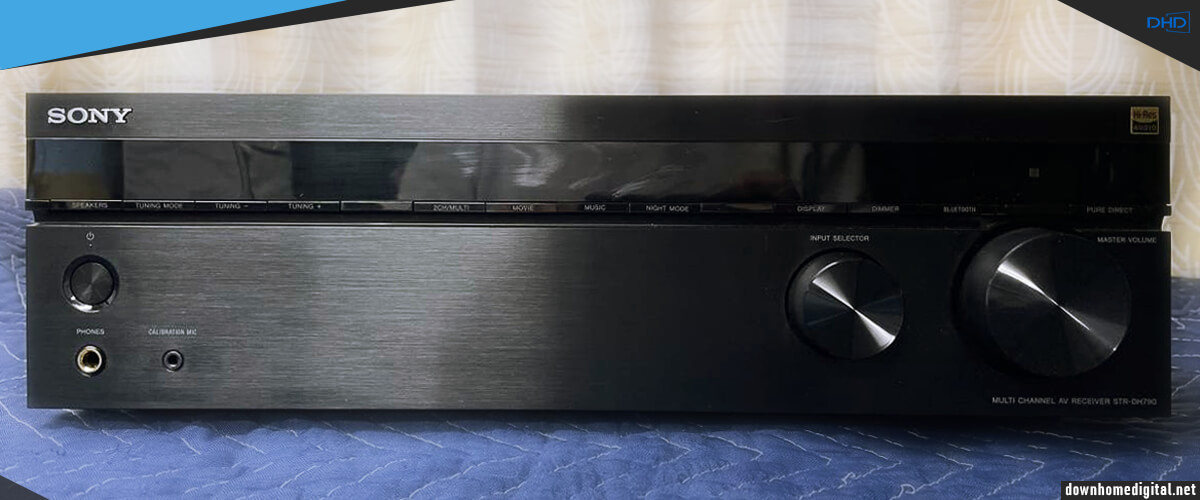
As for the sound, I tested it on a simple 5.1.2 Dolby Atmos configuration. I have noted before that the difference between the top two and top four speakers is minimal for a single viewer. In addition, the Sony auto-calibration feature worked perfectly, and I really enjoyed the sound quality!
I fully appreciated the delights of the object-oriented Atmos format, feeling all of Spider-Man’s jumps and could even track his trajectory. The soundtrack to the film, played by DH790, was rendered with a high degree of realism.
The quality of the music was equally excellent, which I tested in Stereo, Direct, and Pure Direct modes along with the standard All Channel Stereo.
The Sony DH790 has built-in overload protection. When I tried to insert the wrong speaker cable into the clamp connector, a short circuit occurred. The overload and protection message appeared briefly on display, and then the receiver shut down. After fixing the speaker connection situation, I turned the receiver back on through the front panel button since the remote did not work in safe mode. It started with no problems, with the volume prudently resetting to zero.
Sony STR-DH790 is the best Sony receiver of my rating because it represents a balance of price/functionality. Yes, there is no need to talk about the high quality of the design; the receiver costs quite a bit, but all the declared functions work very well. The brand has opted for sound quality, surround or stereo formats, and neglected some modern chips.
The receiver has few HDMI ports, the maximum video resolution is 4K/60Hz, and no Wi-Fi. But taking into account the release in 2018 – this is quite an acceptable outfit. Nevertheless, I want to draw your attention to how long this model has been on the market, winning users’ hearts and not needing an alternative. Those who know a lot about sound and do not want to go broke will be able to appreciate this “guy.”
| Power |
|
| HDMI features |
|
| Video features |
|
| Network |
|
| Surround sound processing |
|
Pros
- Optimal price/quality/functionality ratio.
- Excellent sound quality.
- Neiral X sound processor, which adds spatiality to the sound of conventional stereo.
- Signal-to-noise characteristics are higher than those of the more expensive Denon.
- Not much heat and does not make extraneous sounds.
- Bluetooth module compatible with the AAC codec.
Cons
- No network connections.
Sony STR-DH590 – budget Sony receiver

Sony STR-DH590 provides quite good sound quality in a 5.2 configuration at 145W/6 Ohms per channel (at 8 Ohms, it will look like about 90W, which is very good for such a small system). And, like the STR-DH790, the receiver works well with speakers in the igu6 ohm to 16 ohm range. I think this can be considered a plus since we are talking about the most budget device of my selection because if you already have speakers, you don’t need to upgrade them.
The STR-DH590 and STR-DH790 use the same case, so I won’t tell you about their fragility again. Except that there are even fewer connectors than the 7-channel leader of my rating. But it’s worth mentioning that I didn’t describe in the predecessor’s review the fact that the receiver overheats a lot during prolonged use. It’s normal for a super-budget device, but you must take care of additional ventilation. The remote control is simple, like from my childhood, made of cheap plastic, and the buttons are a bit laggy. But the receiver has so few features that I didn’t even have time to be upset about it.
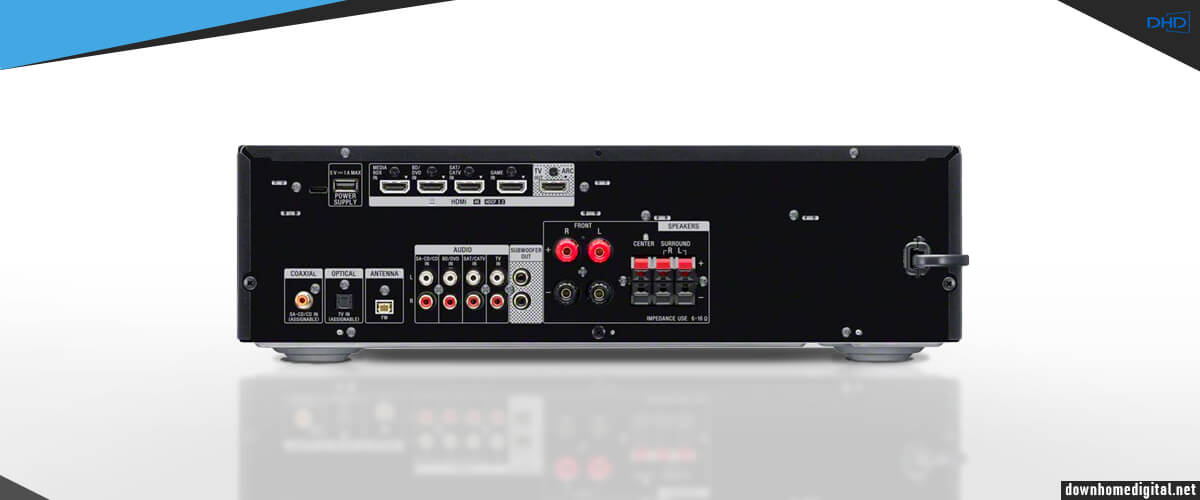
In terms of connectivity, the Sony STR-DH590 offers everything you need for an entry-level receiver. Thus, 4 HDMI inputs can carry Ultra HD and 3D signals without loss of sound or even without colorimetric sampling. The ARC output provides the output. All HDMI 2.0 inputs that are HDCP 2.2 compliant for transmitting all existing video streams to your TV. Supports 4K at 60Hz with HDR10, HLG, or Dolby Vision dynamic metadata.
As expected from the Sony receiver, the sound during the test was pretty good, but not without the help of S-Force Pro Front Surround technology. I heard an enveloping sound with precise positioning of audio objects – as good as possible with an extremely cheap receiver. And thanks to Sony’s Dolby Pro Logic and DSP technologies, the sound was as detailed as possible, with no loss. The receiver has Advanced D.C.A.C. calibration, but it’s simple and creates a rather flat sound. Knowing that Sony can do more, I used the manual settings and achieved, if not great, then a pretty good decent level.

With Hi-Fi music, the receiver also copes well because of the vast number of supported codecs. Sounds excellent and loud. But let’s be honest: the STR-DH590 has an NHD rating of 0.9%, which means you’ll never be able to crank the volume to the max. That’s where the receiver wheezes and coughs. But it’s still better than regular portable speakers or a boombox. And I was most pleased with the presence of music transmission via Bluetooth. The sound was pleasant, with no lag or interference.
The Sony STR-DH590 has the actual performance expected from the best budget Sony receiver. The model has been on the market since 2018, just like its counterpart in the first place ranking, which only means that it fulfills its main task – providing surround sound – well. For all its simplicity, the AVR’s versatility is surprising. With it, you can watch movies with high-quality pictures and 3D sound and listen to music from external sources or via Bluetooth. It has a good, clear sound. And if this is enough for you, you will unlikely find a cheaper device of this quality.
In fact, it is a simpler version of the Sony STR-DH590 with the same pros and cons but with fewer channels. Therefore, with a cost difference of about 100 dollars, I would choose the 7-channel device.
| Power |
|
| HDMI features |
|
| Video features |
|
| Network |
|
| Surround sound processing |
|
Pros
- Quite powerful for a small system (the indicator is identical to STR-DH790).
- Works with speakers in the range from 6 to 16 Ohms.
- No interference or failures were observed during Bluetooth playback.
Cons
- Severely overheats during operation.
- No Wi-Fi or Ethernet wireless connectivity.
- Rattles at high volume.
- Advanced D.C.A.C. calibration creates a simple, flat sound.
Sony STR-ZA3100ES – top Sony under $2000
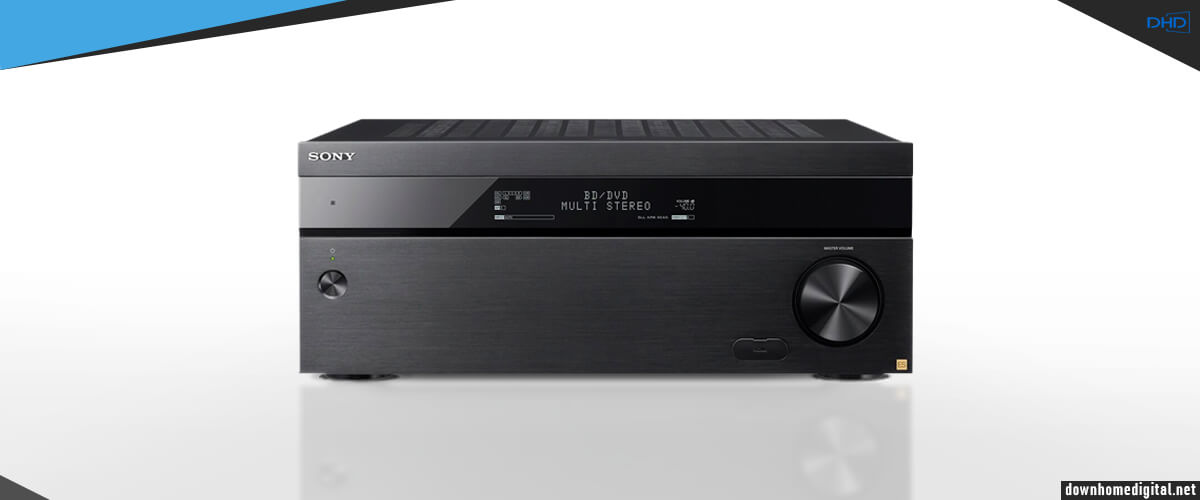
The Sony STR-ZA3100ES supports 110 W at 8 Ohm actual power but can boost up to 9 (using an external amplifier) + 2 simulated channels via the Phantom system. Moreover, I can note the presence of the latest in surround sound formats, such as Dolby Atmos and DTS:X, in the 7.2 configurations. Such good specs lend themselves to full automatic calibration thanks to D.C.A.C. EX. This system can analyze 31 frequency bands to adjust the response of the speakers according to the spatial characteristics of the room. But a THD of 0.9% doesn’t meet today’s standards for sound clarity, so you won’t be able to use the full power.
The receiver is a representative of the oldest and, in its time, premium line of ES; therefore, it is quite a reliable device. Its weight is 28 lbs, so the metal case is tough, and the control is hidden under a protective cover on the front panel. But externally, Sony hasn’t changed anything for a long time, and STR-ZA3100ES looks quite standard. It should still be noted that overheating is practically not observed. I am not delighted with the rather small inscriptions on the LCD, but still, they can be seen from afar, and the screen is quite bright.

The receiver has good video capabilities. STR-ZA3100ES is compatible with UHD / 4K signals with HDCP 2.2 protection, HDR color space, and BT.2020. Another thing is that most content today is still produced in 4K resolution, and I believe that 8K is not a vital parameter when choosing an AVR. The main thing is that the picture should be stable, and this model has it all right.
However, what really disappointed me was the lack of wireless communication protocols. In this receiver, I did not find any AirPlay, Bluetooth, or Wi-Fi. Internet connection is possible only via Ethernet. And then, the Internet connection is used only for connecting to the receiver via IP. This makes it possible to manage and configure the device.
I conducted the test, already expecting how the receiver would sound. And I was not disappointed. When watching a movie, I got an all-encompassing sound with precise positioning of objects on the sound stage. The film’s dialogues were clear and seemed to come only from the center. The frequency response was balanced, and even the bass was powerful enough. I also liked the “live” movement of objects across the sound field. Each action was accompanied by a corresponding sound from the corresponding point. This maximized the atmosphere of presence.
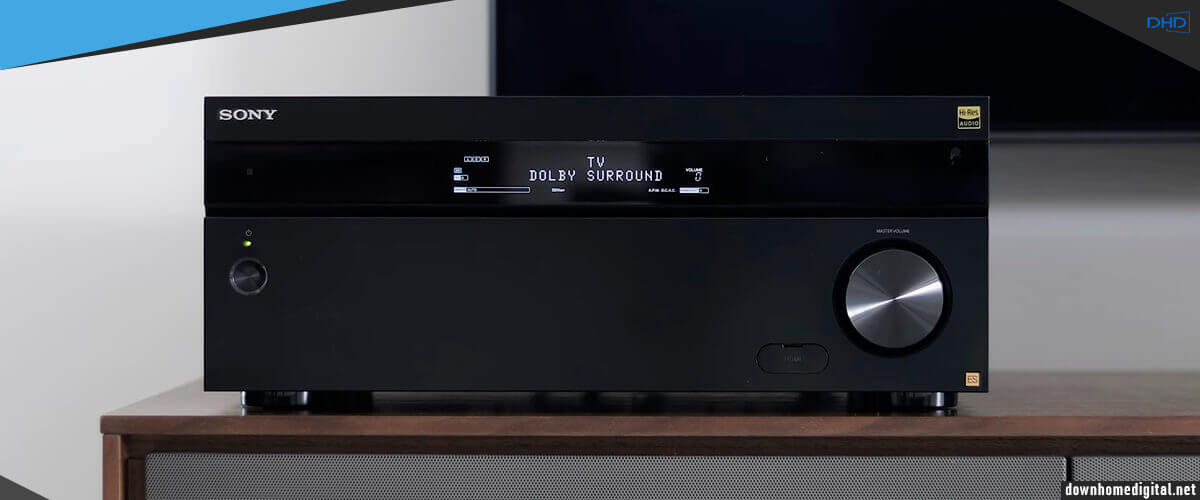
In terms of a Hi-Fi music system, the receiver also performed well enough. Although the upper and lower frequencies sounded good, the sound had accentuated mids but without apparent features. I can’t emphasize sharp highs or deep bass. Everything is in place and the songs are played exactly as they were intended. Compared to the Sony STR-ZA2100ES, the STR-ZA3100ES has slightly better bass reproduction. Low frequencies begin to shake the room even at low volumes. I would even say that explosions and special effects are “physically” felt.
The Sony STR-ZA3100ES has established itself as a great home media center for movie lovers. But it’s been around for far too long. In 2017, the receiver was at the top of the wish list for many users, but today, it’s only valuable for its internal components. Most of the common features today – Bluetooth, Wi-Fi, built-in streaming services, and multi-room wireless audio – are missing in this model. And video streaming is available at today’s lowest resolution quality of 4K/60Hz.
Nevertheless, the AVR stays afloat. The level of excellent realistic sound is still surprising, as more modern devices sometimes sacrifice this parameter in favor of functionality. Moreover, its main plus is its ability to create 11 channels out of 7, albeit with an external amplifier and additional simulation. I believe that STR-ZA3100ES is the top Sony AV receiver in the brand’s lineup under $2000. Do you think we should expect new products from them soon?
| Power |
|
| HDMI features |
|
| Video features |
|
| Network |
|
| Surround sound processing |
|
Pros
- The receiver has wonderful speaker virtualization.
- The sound is well detailed, and there are no problems with voice/dialogue recognition.
Cons
- Does not meet the current standards of the premium lineup.
- High THD, the receiver produces distortion at maximum volume.
- No AirPlay, Bluetooth, or Wi-Fi.
Sony STR-ZA2100ES – great Sony receiver under $1500
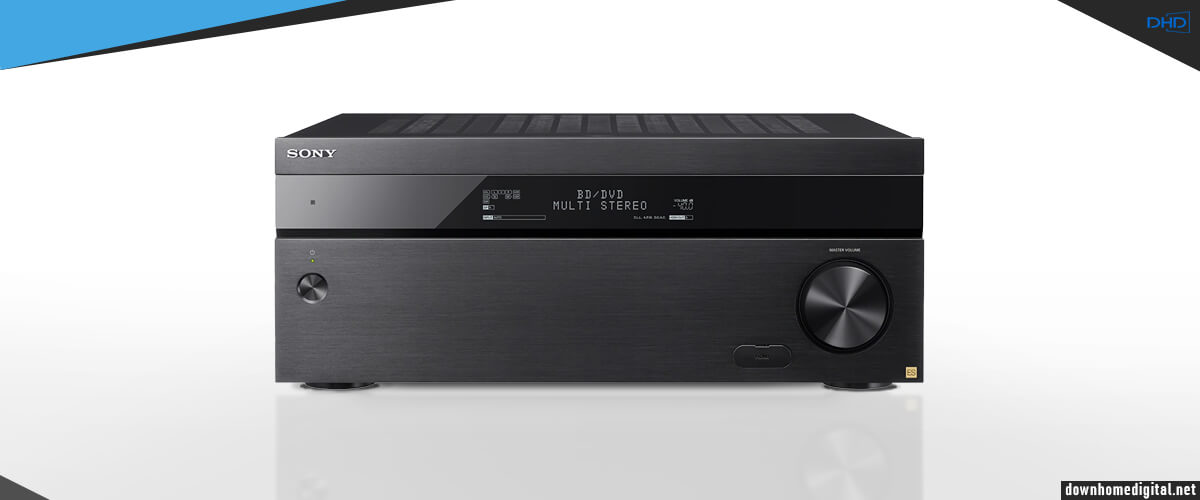
Sony STR-ZA2100ES is a large 7.2 channel receiver with 105 watts at 8 ohms per channel, which turned out to be slightly weaker than the Sony STR-ZA3100ES. This power of the amplifier section makes it possible to control the primary home theater system of speakers and sound Zone 2 and Zone 3.
Sony doesn’t give a chance to turn around in the description of its devices. STR-ZA2100ES is not just similar to the previous receiver. It is the same case with different functions (almost identical, it should be said). I was unhappy with the protective cover this time; it doesn’t hold in the grooves. Sometimes, it seemed to me that it was ready to fall out from one of my glances. Of course, the remote control is outdated; I prefer simple but programmable remote controls. But today you can buy a replacement if it bothers you a lot. The 8-port gigabit switch is a plus for me.
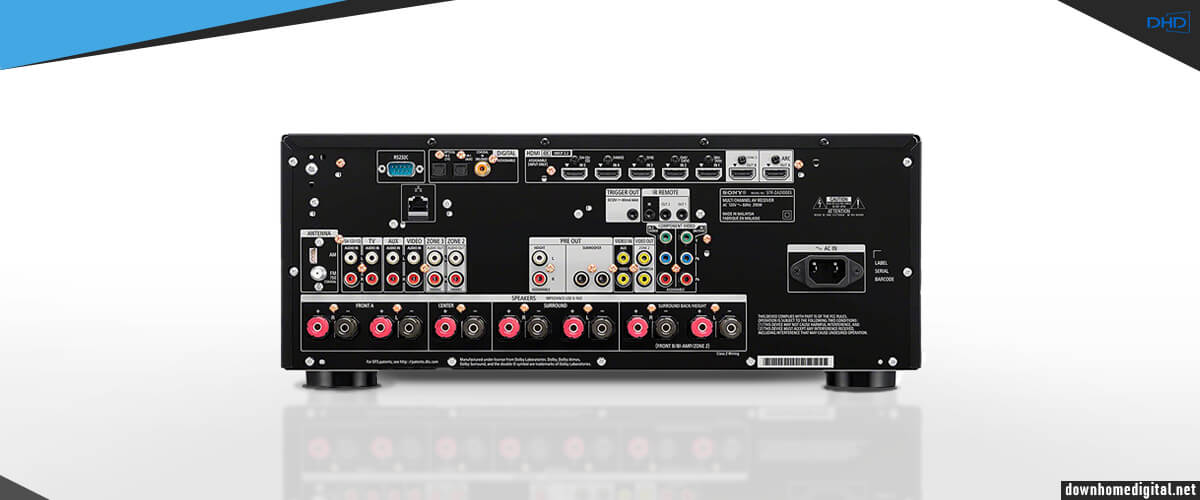
I can say with confidence that the receiver has well-equipped the video path. It has 6 HDMI inputs and two outputs, as well as a component video terminal. The receiver is, of course, 4K compatible, so the video signal is outstanding quality, even 4K HDR! Since the receiver also has an up-scaling function, you can connect all devices that still support 4K and get a better image output. The important fact remains that I can feed the image to two zones simultaneously from different devices. A big step forward is the recent addition of eARC support with firmware 1.051.
What strikes me as odd is the lack of a Bluetooth option. And not only Bluetooth. There is no wireless connection. I didn’t see Wi-Fi, streaming support, or even a Chromecast on this receiver. The only way this receiver can communicate with the “outside world” is through the Ethernet port. But it’s entirely possible that I’m too spoiled. If you read the reviews, you’ll find that many people prefer not to have streaming services and wireless internet built in; they get in the way of focusing on what’s important. This problem can always be solved with external devices.
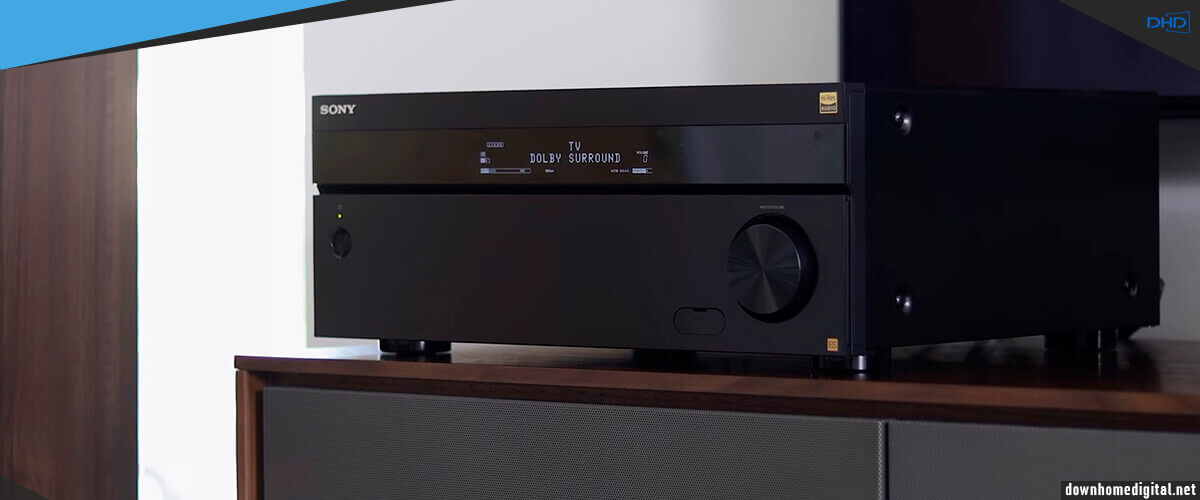
When starting the test, I used automatic calibration. This system pleasantly surprised me with the speed and accuracy of its work. In addition, I immediately use several virtualization modes to compensate for the speakers missing in the configuration.
From the first minutes, I heard a balanced and detailed sound. The action scenes were lightning fast. I didn’t notice any delay between sound and picture. With this sound, the film seemed very “alive” to me and I got an excellent movie experience. However, the bass turned out to be less saturated. I saw that the sound was simple and did not get chills. The situation is like music playback. The receiver emphasizes the midrange. The vocal parts are perfectly discernible, but the bass power is still lacking.
To summarize, the Sony STR-ZA2100ES is a great receiver for creating a local home theater with outstanding 4K images. If you are one of those users who find network services and music streaming from other devices a hassle, this receiver will satisfy most of your needs.
In terms of its functionality and features, it stands side-by-side with the more expensive Sony STR-ZA3100ES, and whether it is worth overpaying is your decision. But still, less power and weak bass play a role in the overall soundstage and make it dimmer. However, this model is one of the best Sony home theater receivers regarding signal quality, dispersion, and balance.
| Power |
|
| HDMI features |
|
| Video features |
|
| Network |
|
| Surround sound processing |
|
Pros
- You can feed two zones simultaneously from different devices.
- Recently added eARC support with firmware 1.051.
- 8-port gigabit switch.
Cons
- The protective cover on the panel is falling off.
- Weak bass.
- Add the same shortcomings as the STR-ZA3100ES.
Sony STR-ZA1100ES – perfect Sony receiver under $1000
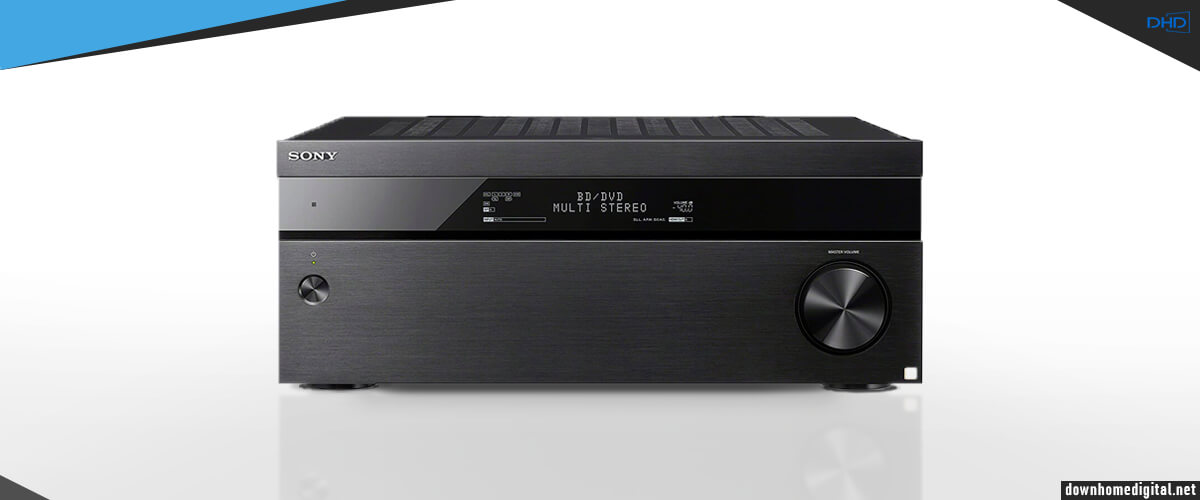
The next receiver on the review is the Sony STR-ZA1100ES. Like STR-ZA3100ES, this receiver works in a 7.2 configuration. So it’s simpler in that sense. Based on the ZA lineup and specs, I can say this receiver is aimed primarily at serving as a home theater center. Dolby Atmos and DTS: X sound decoders and sufficient power of 100 W at 8 Ohm per channel. Also, I cannot fail to mention the great option – Phantom Surround Back, a striking detail of the ES lineup. It allows you to make the soundstage more spacious by creating virtual speakers, creating a system with 9 channels.
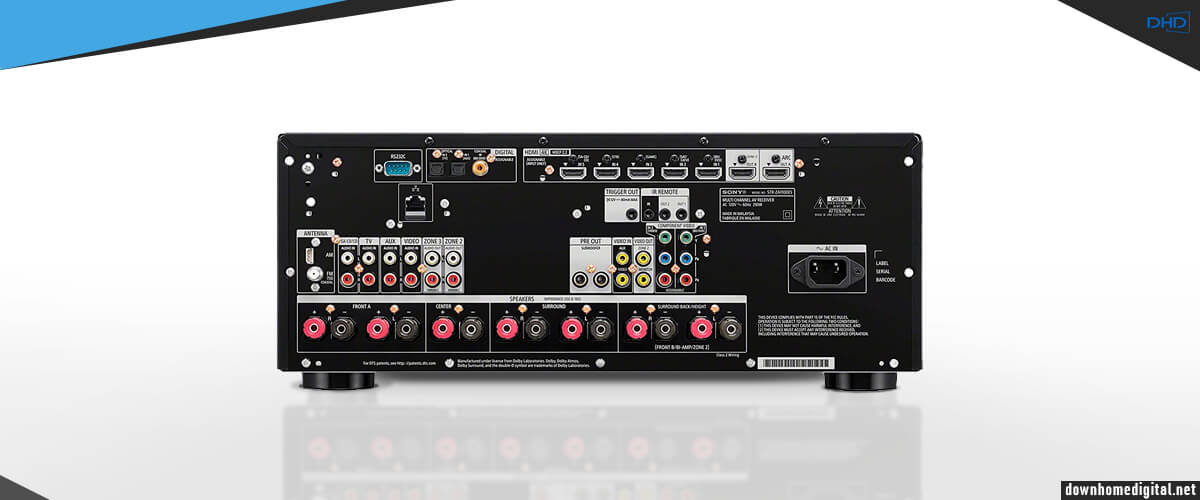
Once again, it’s the same case, with the same drawbacks and advantages. Despite the fact that it is a bit simpler and quite a bit cheaper than STR-ZA3100ES, it is still quite heavy and sturdy, which distinguishes it from similar receivers of this price category. And you’re paying for exactly that – quality that will stay with you for years to come. It still makes sense to have a premium device, albeit of the last generation. The buttons are pressed softly and precisely, and the round regulator rotates smoothly and clearly sets the necessary volume. I must say that the receiver almost does not overheat, which I expected from a device that is now in the budget segment.
The STR-ZA1100ES fully supports 4K resolution in native mode and after up-scaling. Also, I enjoyed implementing the HDR and Dolby Vision modes, which positively affect the picture quality. All of these features are available on each of the HDMI ports. There are 5 inputs and 2 outputs (this is less than its predecessors, and less than the STR-DN1080), one of which is intended for displaying images to Zone 2 which the Sony STR-DN1080 model lacks.
Having tested the receiver with the film, I can say that the sound is really surrounded. Thanks to the D.C.A.C. customization system. All the sounds are in their places. The dialogues feel like they come straight from the screen. The dialogues are perfectly audible. And all the sounds move correctly across the sound stage in sync with what is happening on the screen. What I really lacked was the powerful bass compared to models with a more powerful amplifier. And yet I have to say that the bass, although not strong, is deep enough. In the scene with explosions, I got the right feeling of these effects.
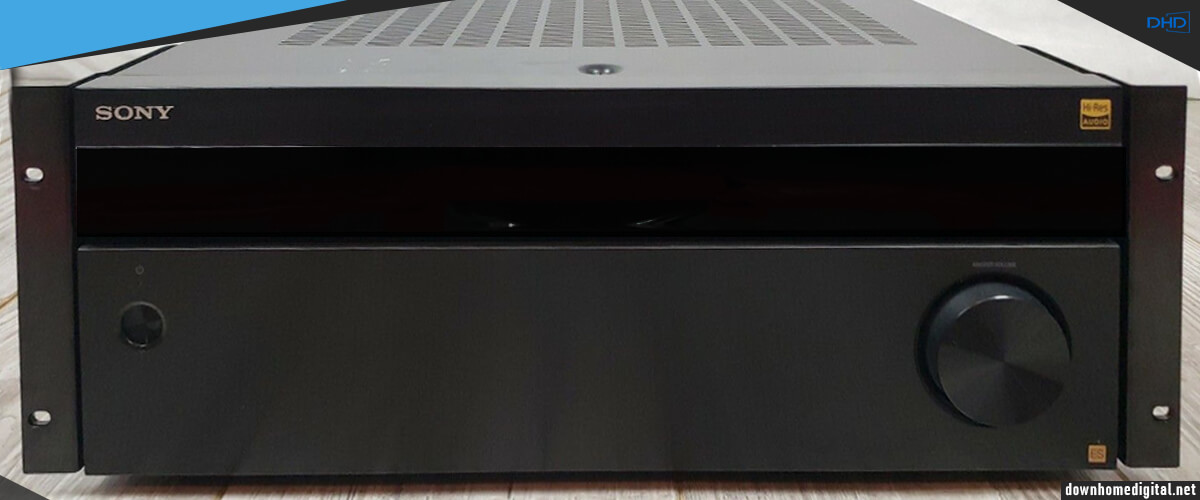
The situation with music is very similar. The sound is pretty detailed and clean. I would not say that there are any pronounced frequencies. It is simple but at the same time of high quality. A disadvantage, I would say, is the inability to play music from streaming services or via Bluetooth. Whether wired or wireless, I could distinguish each instrument in the songs. I especially liked the transfer of stringed instruments. Another important point that I would like to share is that Bluetooth supports the AAC codec. In combination with Apple devices, it is possible to get very high-quality sound even over Bluetooth. But this model doesn’t have a headphone jack if you like to enjoy fully immersive music.
The Sony STR-ZA1100ES is an awesome Sony home theater receiver for under $1000. There are no frills, but it makes a great sound for a minimum Dolby Atmos configuration of 7 channels. It retains all the benefits of the other, more expensive models in the ES lineup, including 2 phantom channels. And despite being somewhat behind the fashion, it sounds just great for its price. It delivers a solid 4K picture, but it has fewer HDMI ports, and you can’t plug in headphones, nor can you listen to streaming audio over wireless.
If you decide to buy this device, you won’t go wrong regarding sound quality. The receiver definitely stands out from similar systems from other brands, creating a good tandem with just about any speaker system I’ve heard. But honestly, there are more advanced devices available today.
| Power |
|
| HDMI features |
|
| Video features |
|
| Network |
|
| Surround sound processing |
|
Pros
- Good sound quality and balance between movies and music.
- Serves 2 zones of audio, which STR-DN1080 does not.
Cons
- It can have a maximum of 9 channels, which is inferior to STR-ZA3100ES and STR-ZA2100ES.
- Fewer HDMI ports than its predecessors and the STR-DN1080.
- There is no possibility of connecting headphones.
Sony STR-DH190 – good stereo receiver from Sony

Sony STRDH190 is a complete home stereo receiver. And it’s the only one on my list. For audio listeners who want modern sound, the NAD integrated amplifier sounds great; pumping out 100 watts per channel at 8 Ohm, the Sony has enough power to push any subwoofer to its loudest volume.
As it should be for an incredibly budget device, the receiver’s case resembles cardboard painted under metal. Ventilation is simply no, so the receiver gets too hot, but it’s good to know that it just shuts down in this case. So you should be concerned about additional cooling. When you take control of the panel, it feels like a child’s toy, especially the regulator, which floats in different directions and tries to jump off the tripod. But nothing actually fell off. The chassis weighs only 14 pounds, so you’ll have no trouble setting it up wherever you want. However, be careful even when plugging it in; the STR-DH190’s connectors aren’t great either.
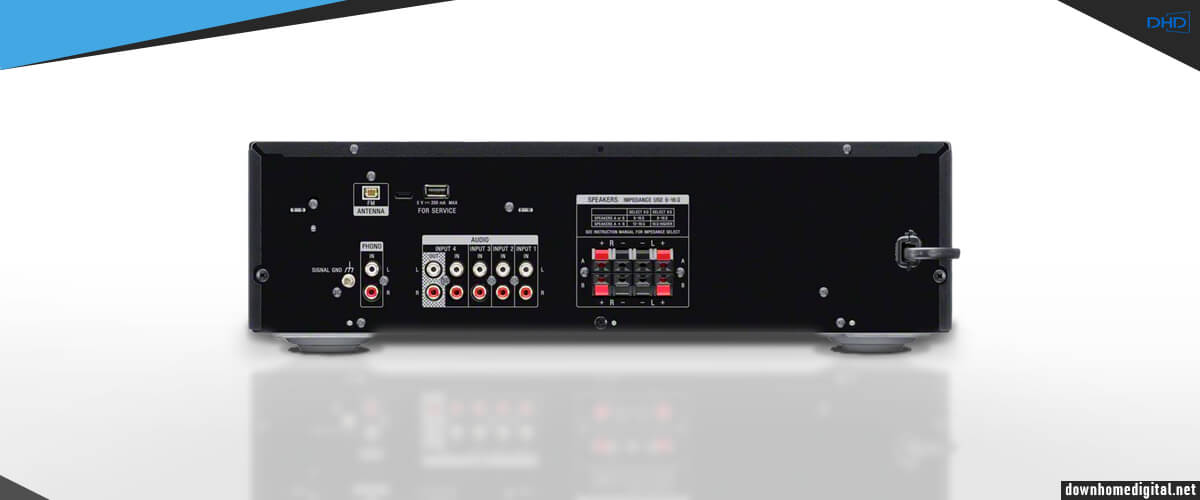
The fact surprised me that as for a simple stereo receiver, this Sony has ample connectivity. Namely, these are four analog inputs and one output connected to a CD player or other recording device. Sony can drive up to two pairs of speakers and have digital connectors on the back to connect to a subwoofer. An excellent option for vinyl lovers is that the STR-DH190 already has a turntable preamp. It is also possible to wirelessly listen from a smartphone, tablet, or computer via Bluetooth. If you want to listen to the radio, note that the FM function only works with Sony’s proprietary antenna.
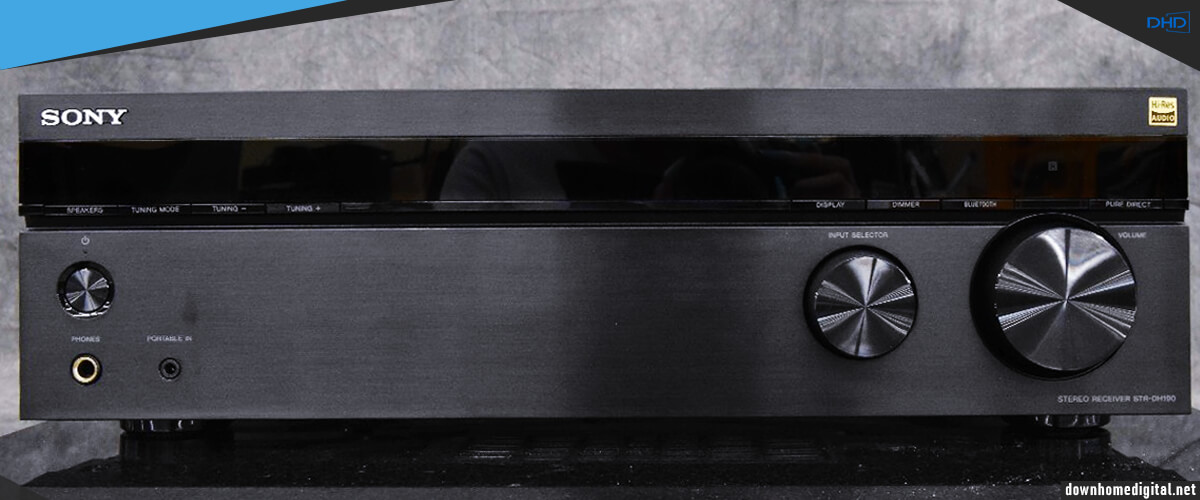
The Sony receiver did not disappoint in this aspect of music reproduction, especially for turntables. I heard excellent sound quality and good frequency balance. When playing Hi-Res audio, the sound was clearer, allowing me to hear more detail. But be honest with ourselves; all that “good” and “quality” is fair in the context of the incredibly low price. It costs less than a portable speaker, but you can’t connect multiple devices to the latter and won’t give you that kind of sound. Still, you should remember that the two-channel STR-DH190 was released in 2018. And this is also an important factor for the reduced price.
Based on the test results, I can confidently call STR-DH190 a superior sound-quality receiver. But I will immediately make a reservation that this title is awarded to it only taking into account the price category it belongs to – the super-budget variant. Do not think that it will satisfy audiophile needs. Of course, it won’t. However, if you are a music lover who wants to have a small system to listen to radio and audio via Bluetooth, CDs, and even vinyl records, then the receiver can well be regarded as an all-in-one device.
| Power |
|
| HDMI features |
|
| Video features |
|
| Network |
|
| Surround sound processing |
|
Pros
- It’s a pretty powerful device.
- It sounds good for its price.
Cons
- Thin-metal lightweight body.
- Heats up a lot when operating.
- The speaker cable connectors are quite fragile.
- FM function works only with a Sony-branded antenna.
Discontinued models
Every brand I review has models that are no longer in production. And those that I find still quite appealing usually end up in this section, as most often, their disqualification is due to obsolescence, lagging behind more modern models in terms of features. Nevertheless, some users prefer reliability and underpricing to newer models with questionable modern options. Maybe there will be such users among you.
Sony STR-DN1080
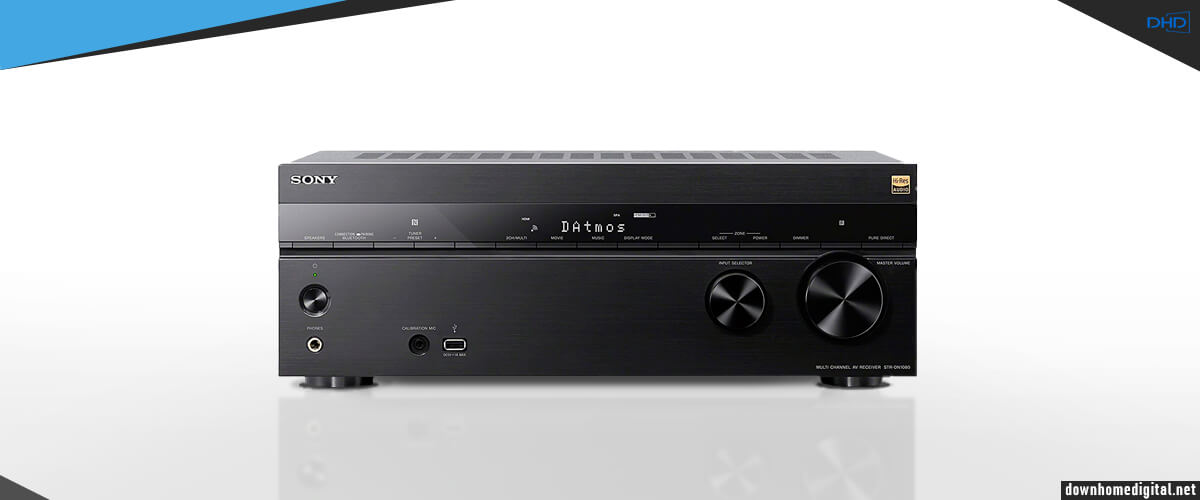
The Sony STR-DN1080 is a 5.1.2 or 7.2 unit with 165 W per channel (6 ohms) and is compatible with Dolby Atmos and DTS: X. I may note that the receiver plays high definition formats such as WAV, AIFF, FLAC, and ALAC, as well as native DSD playback via USB, HDMI or DLNA.
It has six HDMI inputs on the rear that are HDCP 2.2 compliant and supports 4K / 60p 4: 4: 4 content playback (excluding Video1 input) and HDR extended video formats (HDR 10, Dolby Vision, and Hybrid Log-Gamma). It also has two HDMI outputs.
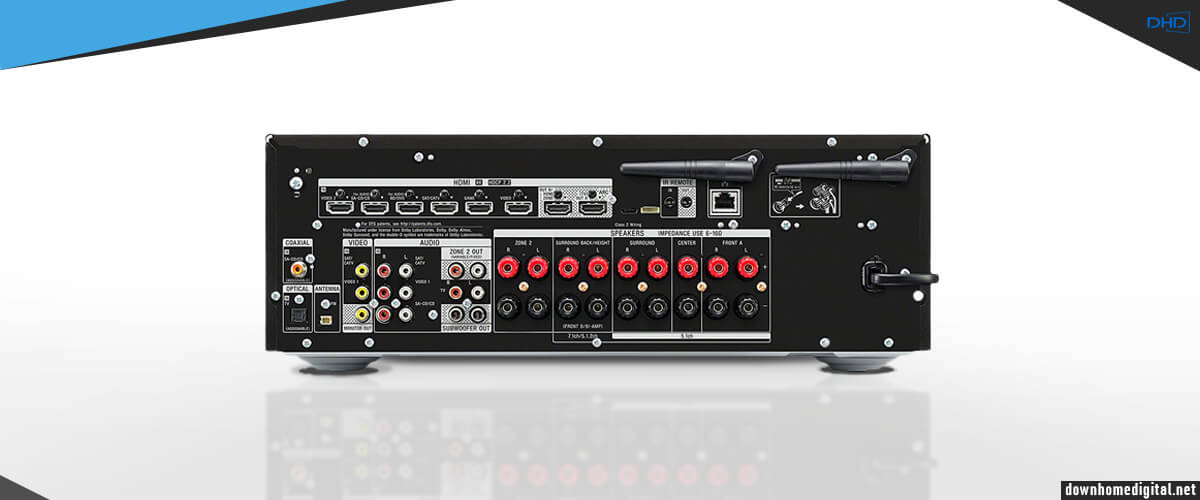
STR-DN1080 has built-in Wi-Fi and Bluetooth support, as well as an Ethernet port for wired connectivity, a significant difference from the Sony STR-ZA1100ES. Unfortunately, it doesn’t have a turntable input. I also found other useful features, including NFC, AirPlay, SpotifyConnect, and Chromecast.
During the test, the receiver showed what it is worth. The power is ideal for small to medium-sized rooms. The most delicate details and most profound layers of sound effects are easily perceived.
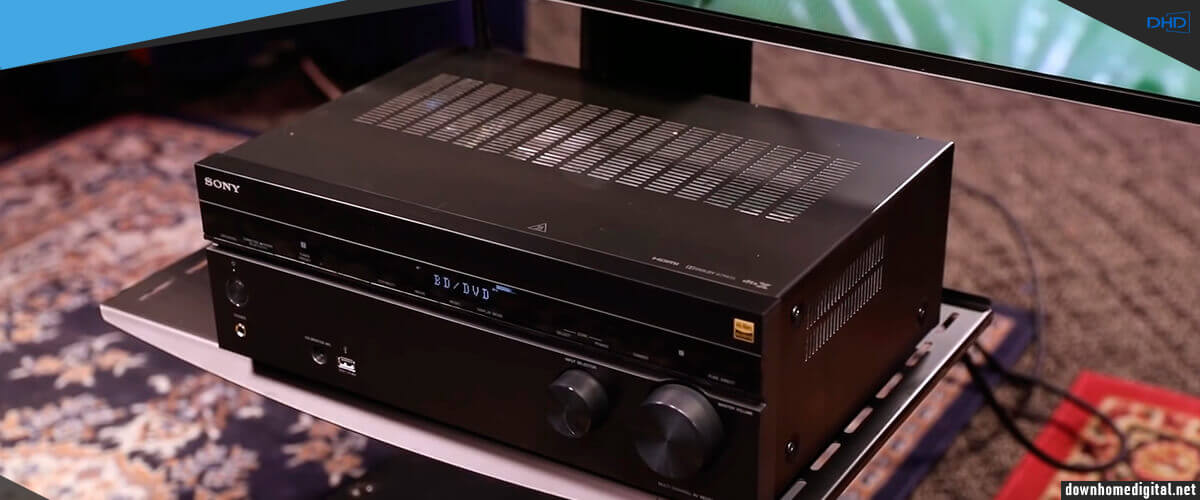
A clear definition of low frequencies improves the overall clarity of soundtracks and dialogues. The surround effects are good and I was able to sense the different directions the sounds were coming from. Rear phantom channels are not as convincing compared to an accurate 7.2-channel setup.
This Sony AV receiver is also very well suited for listening to music. Dynamic changes and voices are smooth and articulate. The sound is crisp, clear, and does not seem bright or harsh when the volume is turned up.
If you’re looking for an affordable home theater AV receiver with advanced music features but still want to enjoy your music, the Sony STR-DN1080 covers both aspects better than any other model in its price range. I highly recommend this excellent option for connecting home theater systems with Dolby Atmos 5.1.2 technology.
| Power |
|
| HDMI features |
|
| Video features |
|
| Network |
|
| Surround sound processing |
|
Pros
- Works well with Hi-Fi music files.
- Phantom Surround Back is available.
Cons
- The GUI is slow and poorly rendered.
Buyer’s guide
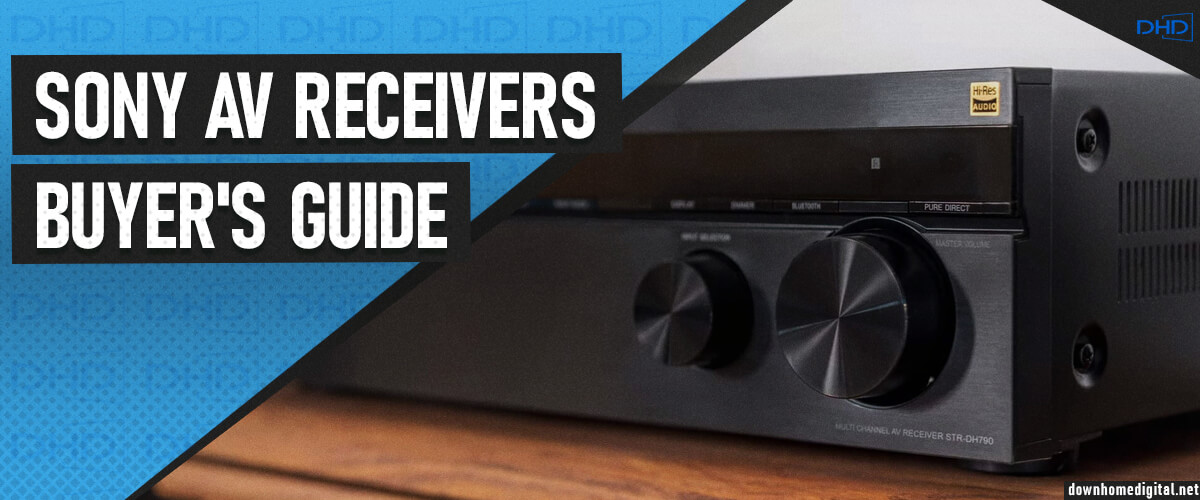
What about watts? How much power do I need?
One of the critical points of buying a receiver is the equipment’s power, although some concepts need to be clarified before we get started.
To start with, power always refers to the load – in this case, the electrical impedance – called impedance and measured in ohms. Manufacturers often advertise the number of watts per channel of their amplifier but do not specify what impedance that figure refers to. A small trap to fatten the numbers that can have unpleasant consequences later at home if we connect a receiver to a speaker that has a higher impedance.
When buying an A/V receiver, a good tip is to look at its power consumption to see if it really will be able to support the wattage consumption promised in the datasheet. Another issue that not everyone agrees on is the watts per channel needed to sound a room, although about 100 watts per channel seems more than enough for a typical room.
How many channels do I need?
The number of channels that the A/V receiver can handle can provide you with more or less surround sound. It depends on the number of speakers of the home theater to which we will connect them. In this sense, 5.1 and 7.1 home theater speakers are the most common. A 5.1 system includes three front speakers, two surround speakers placed on each side of the viewer, and a subwoofer. The 7.1 speakers add two additional channels behind the viewer.
Most quality A/V receivers offer 7.1 or 7.2 system capabilities, and all have 5.1 capabilities. Some of the more expensive A/V receivers can even work with 9.1, 9.2, or even 11.1 systems. But this is overkill. For most users, 7.1 capacity is more than enough, and that’s what we recommend. You can have 5.1-channel speakers (5 speakers + 1 subwoofer), but if you buy an AV receiver with a 7.1-channel capacity, you’ll have no problem if you decide to expand your system in the future by simply adding two more speakers.
Built-in Bluetooth, Wi-Fi, and streaming services
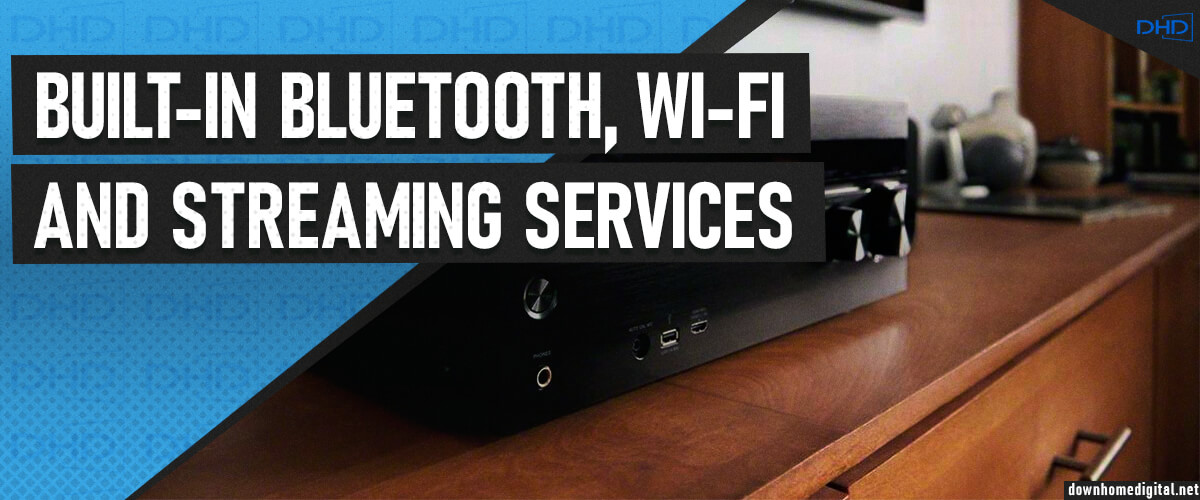
Wireless connectivity in a home theater can be beneficial. An A/V receiver with Bluetooth technology allows you to play audio through your surround speakers using your mobile devices, tablets, or computers as a source. Playback via Bluetooth does not sound as good as a wired system, although, within Bluetooth, there are some codecs such as aptX that allow for outstanding quality.
With Wi-Fi technology, on the other hand, you can connect an A/V receiver to your home internet without the need for an Ethernet cable. This allows you to play music, series, or movies with your home theater system from services such as Spotify, Netflix, or YouTube. Streaming via Wi-Fi generally sounds better than Bluetooth.
4K, HDR, and surround sound formats
Although Full HD (1080p) resolution is of excellent quality, today, many televisions can reproduce images in 4K. This resolution provides impressive image quality and color sharpness. However, the audiovisual content available in this resolution is more limited. To take advantage of 4K capability, many TV and AV receiver manufacturers offer a technology known as “upscaling.” Upscaling is an interpolation technique that uses adjacent pixels to upscale a lower resolution (1080p, for example) to 4K. The quality of an “upscaled” image will never equal that of a native 4K, but this technology achieves excellent results.
A good tip when choosing an A/V receiver is to check if it is compatible with the most commonly used surround sound codecs. There are many Home Cinema codecs, but the three most common are DTS:X and Dolby Atmos.
DTS: X
DTS: X is the simplest codec to use with a 5.1 or 7.1 configuration. This codec does not require any particular physical specification of the speakers. It works with any conventional home theater system, which works with up to 11.2 systems.
Dolby Atmos
Dolby Atmos differs from DTS because it requires one, two, or more ceiling speakers. These speakers are positioned higher than the other surrounding speakers to make the sound move up and down the room. It listed Dolby Atmos systems as 5.1.2 (two additional Atmos modules or speakers) or 7.1.4 (four additional modules). There are also speakers for Dolby that come with drivers that point upwards and do not need to be mounted on the ceiling. The idea is that the sound from these speakers bounces off the ceiling so we get that surround effect from above as well.
Manual setting or D.C.A.C. by Sony: which is better?
Most receivers have both manual and automatic tuning. Manual settings are represented by several equalizer bands, high/low tone controls in the front channels, and a choice of filter cutoff frequency in the subwoofer. Direct modes are also provided for Hi-Fi music, i.e., bypassing all treatments. And manual tuning takes more time and is justified only with a challenging acoustic environment.
What is an auto-calibration system?
The receiver includes a specialized processor that has “hard-wired” software that can automate settings. The system works very simply – a measuring microphone is connected to the receiver. The system emits several sounds of variable frequency, covering the entire frequency range. The result is processed in the receiver and stored as a preset.
The D.C.A.C. by Sony
The automatic system does an excellent job with standard configurations. D.C.A.C. Autocalibration System by Sony determines not only the number of speakers, their characteristics, and the distance between them. However, it also determines the level of background noise in the room. A feature of Sony`s system is that it determines the number of connected speakers and tries to compensate for the missing ones by redistributing information between the available ones. So, for example, in the absence of a center channel speaker, it will be created virtually using the front speakers.

